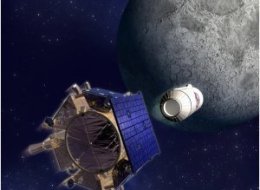 |
| NASA Illustration |
Dr. Tony Phillips, Editor
NASA
Nearly a year after announcing the discovery of water molecules on the moon, scientists have revealed new data uncovered by NASA’s Lunar CRater Observation and Sensing Satellite, or LCROSS, and Lunar Reconnaissance Orbiter, or LRO—and it’s more than just water.
The missions found evidence that lunar soil within shadowy craters is rich in useful materials. Moreover, the moon appears to be chemically active and has a full-fledged water cycle. Scientists also confirmed that ‘moon water’ was in the form of mostly pure ice crystals in some places.
These results are featured in six papers published in the Oct. 22 issue of Science.
The twin impacts of LCROSS and a companion rocket stage in the moon’s Cabeus crater on Oct. 9, 2009, lifted a plume of material that might not have seen direct sunlight for billions of years. As the plume traveled nearly 10 miles above the crater’s rim, instruments aboard LCROSS and LRO made observations of the crater and debris and vapor clouds. After the impacts, grains of mostly pure water ice were lofted into the sunlight in the vacuum of space.
“Seeing mostly pure water ice grains in the plume means water ice was somehow delivered to the moon in the past, or chemical processes have been causing ice to accumulate in large quantities,” said Anthony Colaprete, LCROSS project scientist and principal investigator at NASA’s Ames Research Center.
In addition to water, the plume contained “volatiles.” These are compounds that freeze in the cold lunar craters and vaporize easily when warmed by the sun. The suite of LCROSS and LRO instruments determined as much as 20 percent of the material kicked up by the LCROSS impact was volatiles, including methane, ammonia, hydrogen gas, carbon dioxide and carbon monoxide.
“The diversity and abundance of volatiles in the plume suggest a variety of sources, like comets and asteroids, and an active water cycle within the lunar shadows,” says Colaprete.
The instruments also discovered relatively large amounts of light metals such as sodium, mercury and possibly even silver. Scientists believe the water and mix of volatiles that LCROSS and LRO detected could be the remnants of a comet impact. According to scientists, these volatile chemical by-products are also evidence of a cycle through which water ice reacts with lunar soil grains.
LRO’s Diviner instrument gathered data on water concentration and temperature measurements, and LRO’s Lunar Exploration Neutron Detector mapped the distribution of hydrogen. This combined data led the science team to conclude the water is not uniformly distributed within the shadowed cold traps, but rather is in pockets, which may also lie outside the shadowed regions.
The proportion of volatiles to water in the lunar soil indicates a process called “cold grain chemistry” is taking place. Scientists also theorize this process could take as long as hundreds of thousands of years and may occur on other frigid, airless bodies such as asteroids; the moons of Jupiter and Saturn (including Europa and Enceladus); Mars’ moons; interstellar dust grains floating around other stars and the polar regions of Mercury.
“The observations by the suite of LRO and LCROSS instruments demonstrate the moon has a complex environment that experiences intriguing chemical processes,” said Richard Vondrak, LRO project scientist at NASA’s Goddard Space Flight Center. “This knowledge can open doors to new areas of research and exploration.”
By understanding the processes and environments that determine where water ice will be, how water was delivered to the moon and its active water cycle, future mission planners might be better able to determine which locations will have easily-accessible water. The existence of mostly pure water ice could mean future human explorers won’t have to devise complicated processes to retrieve water out of the soil in order to use it for valuable life support resources. In addition, an abundant presence of hydrogen gas, ammonia and methane could be exploited to produce fuel.
“NASA has convincingly confirmed the presence of water ice and characterized its patchy distribution in permanently shadowed regions of the moon,” concludes Michael Wargo, chief lunar scientist at NASA Headquarters in Washington. “This major undertaking is the one of many steps NASA has taken to better understand our solar system, its resources, and its origin, evolution, and future.”


Be the first to comment on "NASA: Lunar Impact Uncovered More Than Just Moon Water"